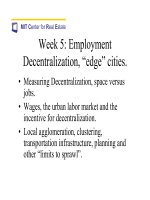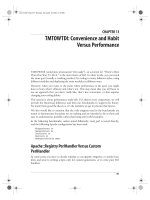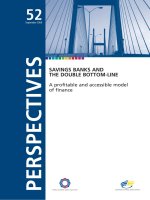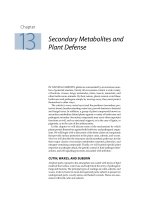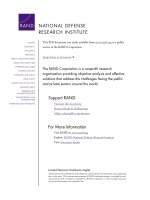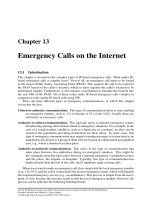Chapter 13 return, risk, and the security market line
Bạn đang xem bản rút gọn của tài liệu. Xem và tải ngay bản đầy đủ của tài liệu tại đây (586.6 KB, 45 trang )
Chapter 13
Return, Risk, and
the Security
Market Line
McGraw-Hill/Irwin
Copyright © 2010 by The McGraw-Hill Companies, Inc. All rights reserved.
Key Concepts and Skills
•
Know how to calculate expected returns
•
Understand the impact of diversification
•
Understand the systematic risk principle
•
Understand the security market line
•
Understand the risk-return trade-off
•
Be able to use the Capital Asset Pricing
Model
13-2
Chapter Outline
•
Expected Returns and Variances
•
Portfolios
•
Announcements, Surprises, and Expected
Returns
•
Risk: Systematic and Unsystematic
•
Diversification and Portfolio Risk
•
Systematic Risk and Beta
•
The Security Market Line
•
The SML and the Cost of Capital: A Preview
13-3
Expected Returns
•
Expected returns are based on the
probabilities of possible outcomes
•
In this context, “expected” means average
if the process is repeated many times
•
The “expected” return does not even have
to be a possible return
∑
=
=
n
i
ii
RpRE
1
)(
13-4
Example: Expected Returns
•
Suppose you have predicted the following
returns for stocks C and T in three possible
states of the economy. What are the
expected returns?
State Probability C T
Boom 0.3 15 25
Normal 0.5 10 20
Recession ??? 2 1
•
R
C
= .3(15) + .5(10) + .2(2) = 9.9%
•
R
T
= .3(25) + .5(20) + .2(1) = 17.7%
13-5
Variance and Standard
Deviation
•
Variance and standard deviation measure
the volatility of returns
•
Using unequal probabilities for the entire
range of possibilities
•
Weighted average of squared deviations
∑
=
−=
n
i
ii
RERp
1
22
))((σ
13-6
Example: Variance and
Standard Deviation
•
Consider the previous example. What are the
variance and standard deviation for each stock?
•
Stock C
σ
2
= .3(15-9.9)
2
+ .5(10-9.9)
2
+ .2(2-9.9)
2
= 20.29
σ = 4.50%
•
Stock T
σ
2
= .3(25-17.7)
2
+ .5(20-17.7)
2
+ .2(1-17.7)
2
=
74.41
σ = 8.63%
13-7
Another Example
•
Consider the following information:
State Probability ABC, Inc. (%)
Boom .25 15
Normal .50 8
Slowdown .15 4
Recession .10 -3
•
What is the expected return?
•
What is the variance?
•
What is the standard deviation?
13-8
Portfolios
•
A portfolio is a collection of assets
•
An asset’s risk and return are important in
how they affect the risk and return of the
portfolio
•
The risk-return trade-off for a portfolio is
measured by the portfolio expected return
and standard deviation, just as with
individual assets
13-9
Example: Portfolio Weights
•
Suppose you have $15,000 to invest and
you have purchased securities in the
following amounts. What are your portfolio
weights in each security?
–
$2000 of DCLK
–
$3000 of KO
–
$4000 of INTC
–
$6000 of KEI
•
DCLK: 2/15 = .133
•
KO: 3/15 = .2
•
INTC: 4/15 = .267
•
KEI: 6/15 = .4
13-10
Portfolio Expected Returns
•
The expected return of a portfolio is the weighted
average of the expected returns of the respective
assets in the portfolio
•
You can also find the expected return by finding
the portfolio return in each possible state and
computing the expected value as we did with
individual securities
∑
=
=
m
j
jjP
REwRE
1
)()(
13-11
Example: Expected Portfolio
Returns
•
Consider the portfolio weights computed
previously. If the individual stocks have the
following expected returns, what is the expected
return for the portfolio?
–
DCLK: 19.69%
–
KO: 5.25%
–
INTC: 16.65%
–
KEI: 18.24%
•
E(R
P
) = .133(19.69) + .2(5.25) + .267(16.65) + .
4(18.24) = 15.41%
13-12
Portfolio Variance
•
Compute the portfolio return for each
state:
R
P
= w
1
R
1
+ w
2
R
2
+ … + w
m
R
m
•
Compute the expected portfolio return
using the same formula as for an
individual asset
•
Compute the portfolio variance and
standard deviation using the same
formulas as for an individual asset
13-13
Example: Portfolio Variance
•
Consider the following information
–
Invest 50% of your money in Asset A
State Probability A B
Boom .4 30% -5%
Bust .6 -10% 25%
•
What are the expected return and
standard deviation for each asset?
•
What are the expected return and
standard deviation for the portfolio?
Portfolio
12.5%
7.5%
13-14
Another Example
•
Consider the following information
State Probability X Z
Boom .25 15% 10%
Normal .60 10% 9%
Recession .15 5% 10%
•
What are the expected return and
standard deviation for a portfolio with an
investment of $6,000 in asset X and
$4,000 in asset Z?
13-15
Expected vs. Unexpected
Returns
•
Realized returns are generally not equal to
expected returns
•
There is the expected component and the
unexpected component
–
At any point in time, the unexpected return can
be either positive or negative
–
Over time, the average of the unexpected
component is zero
13-16
Announcements and News
•
Announcements and news contain both an
expected component and a surprise
component
•
It is the surprise component that affects a
stock’s price and therefore its return
•
This is very obvious when we watch how
stock prices move when an unexpected
announcement is made or earnings are
different than anticipated
13-17
Efficient Markets
•
Efficient markets are a result of investors
trading on the unexpected portion of
announcements
•
The easier it is to trade on surprises, the
more efficient markets should be
•
Efficient markets involve random price
changes because we cannot predict
surprises
13-18
Systematic Risk
•
Risk factors that affect a large number of
assets
•
Also known as non-diversifiable risk or
market risk
•
Includes such things as changes in GDP,
inflation, interest rates, etc.
13-19
Unsystematic Risk
•
Risk factors that affect a limited number of
assets
•
Also known as unique risk and asset-
specific risk
•
Includes such things as labor strikes, part
shortages, etc.
13-20
Returns
•
Total Return = expected return +
unexpected return
•
Unexpected return = systematic portion +
unsystematic portion
•
Therefore, total return can be expressed
as follows:
•
Total Return = expected return +
systematic portion + unsystematic portion
13-21
Diversification
•
Portfolio diversification is the investment in
several different asset classes or sectors
•
Diversification is not just holding a lot of
assets
•
For example, if you own 50 Internet stocks,
you are not diversified
•
However, if you own 50 stocks that span 20
different industries, then you are diversified
13-22
Table 13.7
13-23
The Principle of
Diversification
•
Diversification can substantially reduce the
variability of returns without an equivalent
reduction in expected returns
•
This reduction in risk arises because
worse than expected returns from one
asset are offset by better than expected
returns from another
•
However, there is a minimum level of risk
that cannot be diversified away and that is
the systematic portion
13-24
Figure 13.1
13-25

